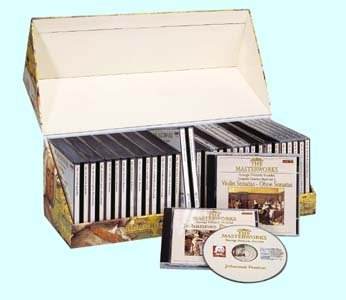
George Frideric HANDEL
(1685 – 1759)
Complete Chamber Music, Volume 1 – Flute Sonatas
Flute Sonata, Opus 1 No. 1a in E minor
Hallenser Sonata No. 1 in A minor
Hallenser Sonata No. 2 in E minor
Hallenser Sonata No. 3 in B minor
Sonata in D major (HWV 378)
Flute Sonata, Opus 1 No. 4 in G major
Flute Sonata, Opus 1 No. 9 in B minor
Flute Sonata, Opus 1 No. 1b in E minor
L’Ecole d’Orphée
Stephen Preston (flute)
Susan Sheppard (cello)
John Toll (harpsichord)
Lucy Carolan (harpsichord)
Recorded 1991
![]() BRILLIANT CLASSICS 99777-35 [74.22]
BRILLIANT CLASSICS 99777-35 [74.22]
George Frideric HANDEL
(1685 – 1759) – Complete Chamber Music,
Volume 2 –Violin Sonatas, Oboe Sonatas
Violin Sonata in A major
Violin Sonata in G minor
Oboe Sonata in B flat major
Violin Sonata in D minor
Oboe Sonata in C minor
Violin movement in A minor
Violin Movement in Cm minor
Oboe Sonata in F major
Violin Sonata in D major
L’Ecole d’Orphée
John Holloway (violin)
David Reichenberg (oboe)
Susan Sheppard (cello)
Lucy Carolan (harpsichord)
Recorded 1991
![]() BRILLIANT CLASSICS 99777-36 [57.42]
BRILLIANT CLASSICS 99777-36 [57.42]
George Frideric HANDEL
(1685 – 1759) – Complete Chamber Music,
Volume 3 – Trio Sonatas Opus 2
John Holloway (violin)
Micaela Comberti (violin)
Stephen Preston (flute)
Philip Pickett (recorder)
Susan Sheppard (cello)
Robert Woolley (harpsichord)
John Toll (harpsichord)
Recorded 1991
![]() BRILLIANT CLASSICS 99777-37 [60.21]
BRILLIANT CLASSICS 99777-37 [60.21]
George Frideric HANDEL
(1685 – 1759) – Complete Chamber Music,
Volume 4 – Trio Sonatas Opus 5
John Holloway (violin)
Micaela Comberti (violin)
Susan Sheppard (cello)
John Toll (harpsichord)
Lucy Carolan (harpsichord)
Recorded 1991
![]() BRILLIANT CLASSICS 99777-38 [70.18]
BRILLIANT CLASSICS 99777-38 [70.18]
George Frideric HANDEL
(1685 – 1759) – Complete Chamber Music,
Volume 5 – Trio Sonatas for 2 Violins and basso
continuo
John Holloway (violin)
Micaela Comberti (violin)
Alison Bury (violin)
Susan Sheppard (cello)
Lucy Carolan (harpsichord)
Robert Woolley (harpsichord)
Recorded 1991
![]() BRILLIANT CLASSICS 99777-39 [65.41]
BRILLIANT CLASSICS 99777-39 [65.41]
George Frideric HANDEL
(1685 – 1759) – Complete Chamber Music,
Volume 6 – Recorder Sonatas
Philip Pickett (recorder)
Rachel Beckett (recorder)
Susan Sheppard (cello)
Lucy Carolan (harpsichord)
Recorded 1991
![]() BRILLIANT CLASSICS 99777-40 [66.52]
BRILLIANT CLASSICS 99777-40 [66.52]